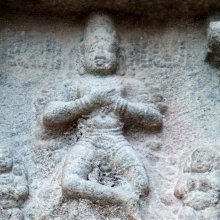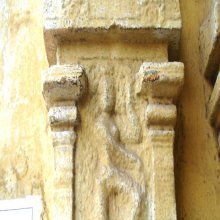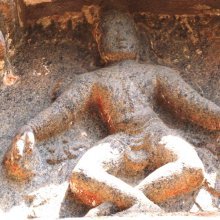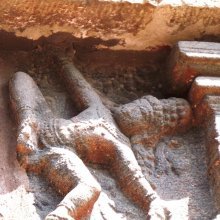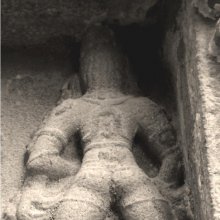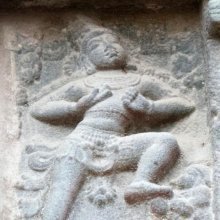Foot, Feet: 3 definitions
Introduction:
Foot means something in Hinduism, Sanskrit. If you want to know the exact meaning, history, etymology or English translation of this term then check out the descriptions on this page. Add your comment or reference to a book if you want to contribute to this summary article.
Images (photo gallery)
(+220 more images available)
In Hinduism
Natyashastra (theatrics and dramaturgy)
Source: Shodhganga: Elements of Art and Architecture in the Trtiyakhanda of the Visnudharmottarapurana (natya)The Feet refers to one of the major Body Parts with which are associated various gestures and expressions (in Sanskrit Dramas), as conveyed through Āṅgikābhinaya: one of the four divisions of Abhinaya or “ways to convey or represent one’s emotion to others”, according to the Nāṭyaśāstra and the Viṣṇudharmottarapurāṇa, an ancient Sanskrit text which (being encyclopedic in nature) deals with a variety of cultural topics such as arts, architecture, music, grammar and astronomy.—The āṅgikābhinaya includes the histrionic representation of the limbs which is simply known as physical gestures. The aṅgas i.e., major classification of the body parts are six in numbers viz., head, hands, chest, sides, waist and feet.

Natyashastra (नाट्यशास्त्र, nāṭyaśāstra) refers to both the ancient Indian tradition (shastra) of performing arts, (natya—theatrics, drama, dance, music), as well as the name of a Sanskrit work dealing with these subjects. It also teaches the rules for composing Dramatic plays (nataka), construction and performance of Theater, and Poetic works (kavya).
Yoga (school of philosophy)
Source: ORA: Amanaska (king of all yogas): A Critical Edition and Annotated Translation by Jason BirchThe Feet (denoted in Sanskrit as Caraṇa) are used in the Lotus Pose as part of Yogic exercises, according to the Dattātreyayogaśāstra verse 35-38ab.—Accordingly, while describing the lotus pose (padmāsana): “Having carefully placed the upturned feet (caraṇa) on the thighs and the upturned hands in between the thighs, [the Yogin] should fix the eyes on the tip of the nose. [...]”.

Yoga is originally considered a branch of Hindu philosophy (astika), but both ancient and modern Yoga combine the physical, mental and spiritual. Yoga teaches various physical techniques also known as āsanas (postures), used for various purposes (eg., meditation, contemplation, relaxation).
Languages of India and abroad
Nepali dictionary
Source: unoes: Nepali-English DictionaryFeet is another spelling for फिट [phiṭa].—n. 1. feet; 2. foot;
Nepali is the primary language of the Nepalese people counting almost 20 million native speakers. The country of Nepal is situated in the Himalaya mountain range to the north of India.
See also (Relevant definitions)
Starts with: Foot massage, Foot-a-night vine, Foot-soldier, Foot-stool, Footbal-khelnu, Football fruit, Footeco-feso, Footeco-paisa, Foothill death camas, Foothill larkspur, Foothill sagewort, Footja, Footnot, Footon, Footpath, Futkar.
Ends with (+21): American goosefoot, Arrowhead sweet coltsfoot, Arrowleaf sweet coltsfoot, Blite goosefoot, Broad-leaved goosefoot, California goosefoot, Carolina ponyfoot, Common crowfoot, Cow foot, Cursed crowsfoot, Deer-foot, Elephant foot, European crowfoot, Fetid goosefoot, Fowl foot, Garden crowfoot, Goosefoot, Hawaiian goosefoot, Jerusalem oak goosefoot, Lotus feet.
Full-text (+8477): Pada, Padati, Padatala, Padodaka, Padapitha, Padya, Padagra, Carana, Panipada, Caranamrita, Padamula, Amhri, Padanyasa, Paduka, Patti, Padapranama, Kakapada, Samicina, Sayaniya, Yogya.
Relevant text
Search found 472 books and stories containing Foot, Feet, Fit, Fut; (plurals include: Foots, Feets, Fits, Futs). You can also click to the full overview containing English textual excerpts. Below are direct links for the most relevant articles:
Chandogya Upanishad (Shankara Bhashya) (by Ganganatha Jha)
Section 3.18 (eighteenth khaṇḍa) (six texts) < [Chapter 3 - Third Adhyāya]
Section 3.12 (twelfth khaṇḍa) (nine texts) < [Chapter 3 - Third Adhyāya]
Section 4.6 (sixth khaṇḍa) (four texts) < [Chapter 4 - Fourth Adhyāya]
Rasa Jala Nidhi, vol 5: Treatment of various afflictions (by Bhudeb Mookerjee)
Chapter 21 - Symptoms and Treatment of Murcha (loss of consciousness)
Chapter 24 - Symptoms and treatment of Apasmara (epilepsy)
The Dialectics of Racism: Amiri Baraka’s < [January – March, 1994]
Vivekananda, The Poet < [October – December, 1993]
“Tiruvembavai” < [July – September, 1985]
Trishashti Shalaka Purusha Caritra (by Helen M. Johnson)
Notes on Āsana (postures) < [Notes]
Part 7: Story of Meghakumāra < [Chapter VI - Adoption of right-belief by Śreṇika]
Part 1: Story of Rauhiṇeya < [Chapter XI - The story of Rauhiṇeya]
Tiruvaymoli (Thiruvaimozhi): English translation (by S. Satyamurthi Ayyangar)
Pasuram 4.6.6 < [Section 6 - Sixth Tiruvaymoli (Tirpparai yam ini)]
Pasuram 3.2.6 < [Section 2 - Second Tiruvaymoli (Munnir nalam)]
Pasuram 1.8.10 < [Section 8 - Eighth Tiruvaymoli (Otum pul eri)]
Sahitya-kaumudi by Baladeva Vidyabhushana (by Gaurapada Dāsa)
Text 5.5 < [Chapter 5 - Second-rate Poetry]
Text 10.209 < [Chapter 10 - Ornaments of Meaning]
Text 4.32 < [Chapter 4 - First-rate Poetry]
Related products
(+37 more products available)
